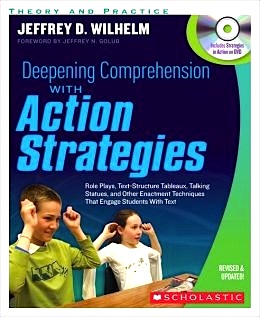Using Drama Techniques to Deepen Comprehension
Deepening Comprehension with Action Strategies (2nd Edition)
By Jeffrey D. Wilhelm
(Scholastic, 2012 – Learn more)
Reviewed by Allyn Hunt
In Deepening Comprehension with Action Strategies (2nd Edition), veteran author Jeffrey Wilhelm successfully embraces the Common Core Standards and educational theory while maintaining and encouraging imagination and creativity in the classroom by using “enactment strategies” or action strategies to engage students. These strategies are drama techniques to be used before, during, and after reading fiction or nonfiction, to help students become fully engaged in a particular moment in learning.

As effective teachers, we know that we must hook our students into our lessons if we stand any chance for them to advance and meet the learning goal. Building on Vygotsky’s claim that “play is the most natural form of learning,” Wilhelm uses drama as a means of engagement, imagination, and identity (p. 67). These enactments make learning very personal and immediate.
As one of the teachers interviewed on the accompanying DVD stated: “it lets (students) live in that reading world we push and promote.”
Examples of Enactment/Action Strategies:
Before Reading Activities:
- Frame the Enactment
- Highlight the purpose
- Cite the goal or problem to be solved
- Emphasize pursued creative actions
- Essential Question
During Reading Activities:
- Doodling—Students draw a character’s inner feelings and then interpret the doodling in the role of guidance counselors.
- Whispers/Good Angel—Students decide what a character needs to know, be reminded of, be advised on, and then decide how to present the information.
- Postcards from the Past—Students create a postcard about an earlier time that is important to the current situation
After-Reading Activities:
- Who Am? —Students portray different characters by taking on their movements or speech.
- Hot Seat—Character interview or Press Conference. Groups of students are interviewed about their experiences (in role of particular characters)
- Statue—Students create a statue with their bodies that highlights and commemorates the story’s meaning.
- Tableaux—Students create visual pictures with their bodies, emphasizing key details and relationships.
- Correspondence Activities (Telephone Call/Telephone Tree, Postcards)
- Job Application
- Medical Report
Other good things about this book
There are many strategies that are explained throughout the book. The accompanying DVD, offering video of teachers using some of these techniques, is very informative. The DVD also has an introductory piece featuring the author — and a Q & A section that I found helpful to refer to as I read the book and now as I plan my own lessons.
For instance, I took to heart the reminders about the importance of framing the lesson because sometimes I get so excited about the short story or novel that I do not prepare the students as thoroughly as I should. I also appreciated seeing the strategies in action and realizing that although the method centers on drama techniques, there is no loss of classroom management or momentum with your lesson or learning goal. With the teacher’s guidance the student is put in the driver’s seat and is able to take more control of his or her own learning and obtain those “aha” moments.
Another strong element of this book is that it shows once again that reading strategies, and in particular these enactment strategies, may be used across all content areas. They are not limited to Language Arts or reading class.
Bravo, Dr. Wilhelm, on another asset for teachers of all subject areas.
Allyn Hunt is the reading support teacher for grades 2-8 at Liza Jackson Preparatory School in Fort Walton Beach, Florida. This is her fourth year in this position after teaching 8th grade Language Arts for seven years. She absolutely loves teaching and being with her students and colleagues.

































